HISTORICAL NOTES
A railway run by a committee? The Cheshire Lines Committee (or just 'CLC') successfully operated 143 route miles of railway in Lancashire and Cheshire until nationalisation of the railways in 1948. It sometimes styled itself 'The Cheshire Lines Railway' although a little over half of the railway was in Lancashire and had no locomotives of its own.
In the 1830s, the success of the early trunk railways like the The London & Birmingham Railway led to a turbulent period of rapid railway development as new railways sought a 'slice of the action' and existing railways defended their own profitability.
The Great Northern Railway (GNR) was set up in 1846. It built and operated what became the southern part of the East Coast Main Line, with the North Eastern Railway operating further north and the North British Railway completing the route to Scotland. The Manchester, Sheffield and Lincolnshire Railway (MS&L), formed by amalgamations in 1847, was a smaller railway with major ambitions involved in many political machinations. The GNR and the MS&L set up the Cheshire Lines Committee (CLC) in 1862 to operate proposed routes in Cheshire. In 1865 the Midland Railway (which had been formed in 1844 by the amalgamation of three railways) became a third, equal partner in the CLC.
The birth of the CLC was largely due to Edward Watkin (later Sir Edward Watkin) who was a prolific railway entrepreneur. In 1897 the MS&L changed its name to the Great Central Railway (GCR), when its London Extension Railway to Marylebone (sometimes called the Great Central Main Line) was being built. The MS&L (later GCR) provided the motive power for the CLC and, initially, the partners provided goods and passenger rolling stock although later the CLC made its own provision.
Under Watkin's direction, the CLC developed four principal routes of its own, with numerous connections to other railways:-
Route 1. Liverpool Central to Manchester Central via Warrington Central.
Route 2. Chester to Manchester Central.
Route 3. Halewood/Hunts Cross to Southport Central via Aintree.
Route 4. Glazebrook to Hyde Jn./Godley Jn. via Stockport Tiviot Dale.
These routes are shown on the Pre-Grouping map below (the Chester route only from Mobberley to Manchester, I'm afraid):-
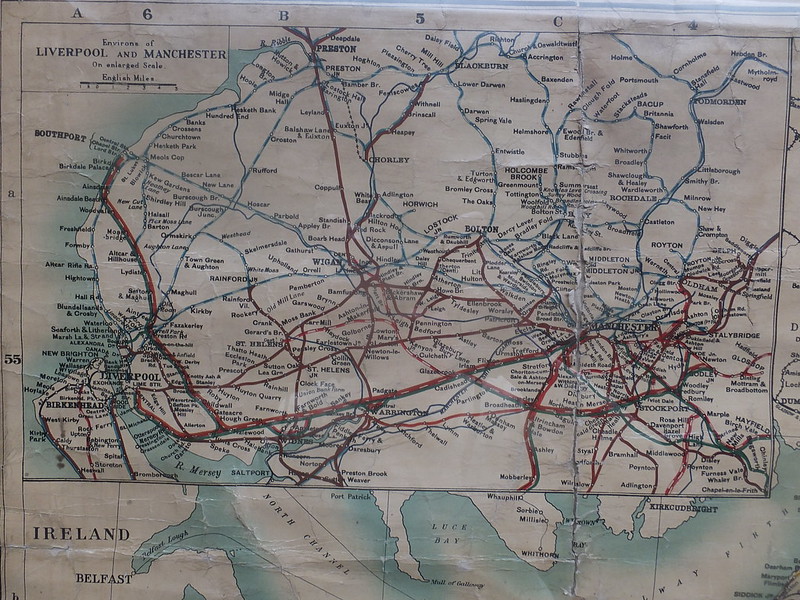
On the above map, CLC routes carry the colours of all three partners:-
Great Northern Railway - Brown
Great Central Railway (formerly MS&L) - White/Red
Midland Railway - Green
Click for larger view.
Route 1. Liverpool Central - Manchester Central
By 1873 the CLC was operating a Liverpool to Manchester service, in competition with the London & North Western Railway (LNWR) and the Lancashire and Yorkshire Railway (L&YR) routes. The non-stop CLC trains completed the journey in around 40 minutes and by 1900 the CLC was carrying more passengers between the cities than the LNWR and L&YR combined.
Liverpool Central
Initially, services terminated rather inconveniently at Brunswick, south of the city centre, but in 1874 Liverpool Central was opened in the heart of the city.
 Liverpool city in 1946. The long trainshed of Liverpool Central station is near the top right and the two trainsheds of Liverpool Lime Street station are top left. Click on image for a slightly larger view.
Liverpool city in 1946. The long trainshed of Liverpool Central station is near the top right and the two trainsheds of Liverpool Lime Street station are top left. Click on image for a slightly larger view.
 Railway Clearing House Map of Liverpool Railways in 1909, showing CLC Lines in Brown (The Liverpool Central end of Route 1 is bottom right, part of Route 3 is top right).
Click for other sizes or to download.
Railway Clearing House Map of Liverpool Railways in 1909, showing CLC Lines in Brown (The Liverpool Central end of Route 1 is bottom right, part of Route 3 is top right).
Click for other sizes or to download.
Widnes
The CLC provided a'fast' route for through trains, whilst the GCR and MR built a loop with a passenger station nearer the town.
Warrington Central
Again, the CLC provided a 'fast' route for through trains and a loop into the station in the town, as shown on the map below.
 Warrington Central, on a loop line to the main CLC.
Warrington Central, on a loop line to the main CLC.
Manchester Central
At first, the CLC line was served by a temporary terminus in Manchester but by 1880 the CLC had opened Manchester Central, with its impressive trainshed. The 210 foot span of the trainshed was exceeded only by Barlow's trainshed at St. Pancras (a visit to St. Pancras is described here). The approach tracks to Manchester Central station had to be raised above ground level to carry the lines over existing roads. Both the MS&L and MR also had running powers into the LNWR's congested London Road terminus.
 Manchester Central Station in 1948, with Deansgate Goods Depot behind (from a damaged negative). Click on image for a slightly larger view.
Manchester Central Station in 1948, with Deansgate Goods Depot behind (from a damaged negative). Click on image for a slightly larger view.
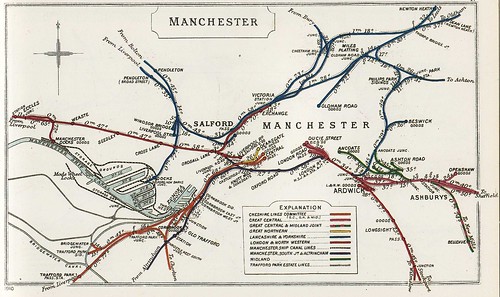 Railway Clearing House Map of Manchester Railways in 1910, showing CLC Lines in Brown. Trains from Chester direction (Route 2, described below) used the MS&LR to Old Trafford Jn. where they diverged to join the CLC Liverpool route to Manchester Central at Cornbrook West Jn.
Railway Clearing House Map of Manchester Railways in 1910, showing CLC Lines in Brown. Trains from Chester direction (Route 2, described below) used the MS&LR to Old Trafford Jn. where they diverged to join the CLC Liverpool route to Manchester Central at Cornbrook West Jn.Click for other sizes or to download..
In 1903, the Midland Railway opened the Midland Hotel, a few yards from the entrance to Manchester Central. The hotel remains open today (see 'THE CLC ROUTES TODAY' below).
Route 2. Chester Northgate to Manchester Central
The CLC route to Manchester started at Chester Northgate station. The Great Central also developed its own network of lines west of Chester both across the Wirral and to Wrexham. The CLC line passed through Northwich, where the Brunner-Mond chemical works at Winnington opened in 1874 (and survives today) generated significant freight business. The CLC route continued to an end-on connection at Altrincham with the Manchester South Junction & Altrincham Railway (MSJ&AR). This was a joint line operated by the LNWR and the MS&L which led to what is now Manchester Piccadilly but at Old Trafford Jn. CLC trains could be diverted to join the CLC Liverpool route at Cornbrook West Jn., reaching Manchester Central station after a further mile..
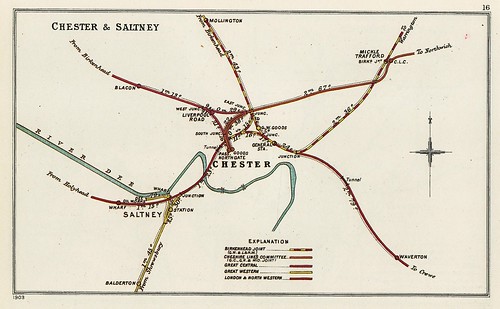
Railway Clearing House Plan of Chester area in 1910 showing the CLC lines in Brown. Click here for larger image
Route 3. Halewood/Hunts Cross to Southport Central via Aintree
A triangular junction between Hunts Cross and Halewood led to the CLC line to Aintree, opened in 1879. The line passed the city of Liverpool on the landward side and tunneled under the L&YR lines near Kirkdale to reach Aintree. A further triangular junction served a branch to Huskisson, within sight of the L&YR Sandhills station. Beyond this triangle, a purely Midland Railway branch diverged and ran for just over two miles to Langton Dock. These important connections to Liverpool Docks generated significant freight revenue. The line was extended to the important resort of Southport by 1881, nearing the coast at Ainsdale and continuing to Southport, where it turned to landward to terminate on the shore side of Lord Street. However, this extension was always disadvantaged because Liverpool to Southport was 31 miles by the CLC route, compared with 18.5 miles on the L&YR route which was electrified.
Southport Lord Street
The railway built a five platform terminus on the seaward side of Lord Street, as shown on the aerial photograph below.
 Southport Lord Street Station (foreground) in 1938. Southport Chapel Street station is in the background. Click on image for a slightly larger view
Southport Lord Street Station (foreground) in 1938. Southport Chapel Street station is in the background. Click on image for a slightly larger view
Route 4. Glazebrook to Hyde Jn./Godley Jn. via Stockport Tiviot Dale
The line from Glazebrook Jn. is shown in the Pre-Grouping map above. The junction at Glazebrook allowed trains from Liverpool direction to divert through Timperley to Stockport Tiviot Dale, where the CLC at low level crossed under the Stockport Viaduct of the LNWR route to Manchester. Beyond Stockport, triangular junctions allowed trains to join the Manchester to New Mills line, a joint GCR/MR affair, heading towards or away from Manchester. Finally, a further joint GCR/MR triangular junction allowed trains to join the original MS&L main line from Manchester to Sheffield again heading towards or away from Manchester. These connections allowed both the GCR and MR ready access to the CLC network from their traditional routes.
THE CLC ROUTES TODAY
The original CLC routes are shown on the Pre-Grouping map above. As a result of the 'Grouping' in 1923 both the LNWR and the MR became part of the London Midland and Scottish Railway (LMS) whilst the GNR and GCR became part of the London & North Eastern Railway (LNER). The CLC continued with the LMS and LNER as partners until 1948 when nationalisation brought all railways together in British Railways.
Many of the railways shown on the above Pre-Grouping map no longer exist. As far as former CLC routes are concerned, it's still possible to travel from Liverpool to Manchester via Warrington Central using the CLC route but the network is much simplified and the arrangements at either end are radically different since both Liverpool Central in its original form and Manchester Central have been abolished. It's also possible to travel from Chester to Manchester on the CLC route - again the original terminal stations have been lost and routes have been reconfigured and simplified. The whole of the line from Halewood/Hunts Cross to Southport Lord Street has gone. Fragments of the Glazebrook to Hyde Jn./Godley Jn. route remain in use although reconfigured and Glazebrook and Godley are no longer junctions.
Route 1 today: Liverpool - Manchester
In my post Day Trip to Southport and Liverpool (Part 2) I outlined the changes made when both Liverpool Exchange (L&YR) and Liverpool Central (CLC) were closed. British Railways drove a tunnel under the city centre so that electric trains from Southport could join up with the lines which had served Liverpool Central and continue on the former CLC line to the limit of third-rail electrification at Hunts Cross. The electrified line from Southport to Hunts Cross now forms part of the Northern Line of the Merseyrail network. Diesel trains from Liverpool Lime Street reach Hunts Cross on the CLC route via the connection at Allerton Junction and continue through Warrington Central to Manchester where they now gain the former MSJ&AR at Castlefield junction and continue to Manchester Oxford Road and Manchester Piccadilly.
Liverpool Central
The Liverpool Central CLC station has gone, but is recalled on the 'Disused Stations' site here.
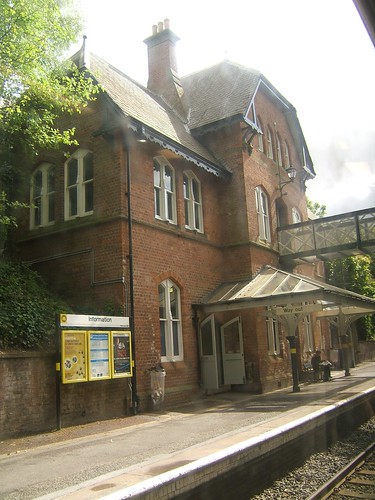
The attractive Cressington Station, on the Liverpool Central to
Hunts Cross Line, survives as part of the Merseyrail network.
Widnes
The loop line has been long abandoned but Widnes Central station which formerly served the town is described on the 'Disused Stations site here. Farnworth station on the direct line is now renamed 'Widnes'.
Warrington Central
In Warrington, the 'fast' route for through trains has been abandoned (and largely built over) but trains continue to call at Warrington Central station within the town.
Manchester Central
Manchester Central is no longer in use as a station, but its railway days are remembered here. The train shed at Manchester Central was retained as an exhibition/conference/event centre, originally called 'G-MEX' but now calling itself Manchester Central.
 The 'country end' of the former trainshed at Manchester Central.
The 'country end' of the former trainshed at Manchester Central.
By 1903, the Midland Hotel had opened and remains open today - more details here.
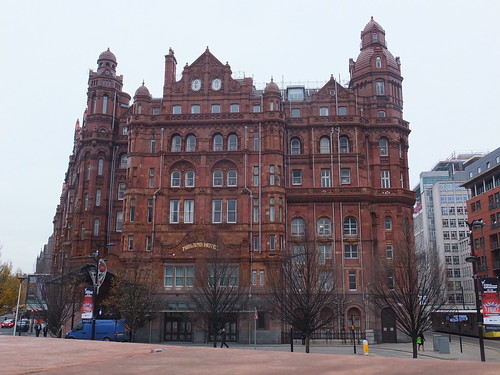 The Midland Hotel, Manchester.
The Midland Hotel, Manchester.
The approach tracks to the station had to be raised above ground level to carry the lines over existing roads. The tracks may have gone but this impressive bridge (which now carries a car park) still looms over Great Bridgewater Street.
 Bridge formerly carrying approach tracks to Manchester Central.
Bridge formerly carrying approach tracks to Manchester Central.
A little further out, a complex lattice bridge was used to carry the CLC tracks and this now carries the trams on the Altrincham route of Manchester Metrolink.
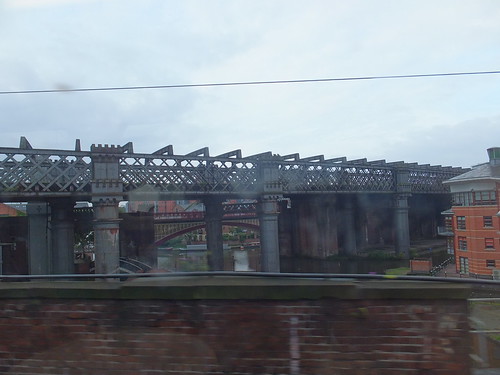 Bridge formerly carrying approach tracks to Manchester Central now part of the 'Metrolink' system.
Bridge formerly carrying approach tracks to Manchester Central now part of the 'Metrolink' system.
Route 2 today: Chester - Manchester
Chester Northgate station was closed in 1969 but it's documented on the 'Disused Stations' site here. A connection at Mickle Trafford now allows trains from the former LNWR station at Chester to gain the CLC route. Northwich still has its chemical works. For a number of years, the Brunner-Mond works was owned by Imperial Chemical Industries (ICI). It is now part of Tata Chemicals Europe. At the Manchester end of the route, since the former MSJ&AR route is now part of the Manchester Metrolink light rail network, trains to Manchester on the former CLC route now diverge at Deansgate Junction (near Altrincham) to reach the Glazebrook - Godley line at Skelton Junction. They then take the Stockport line at Northenden Jn., joining the former LNWR route at Edgeley Jn. and continuing via Stockport to Manchester.
Although the connection from Chester to the former Great Central lines across the Wirral and to Wrexham has been lost, the line from Wrexham through Shotton High Level to Bidston survives as 'The Borderlands Line' and a recent journey is described in the post By rail to Liverpool (Part 1).
Route 3 today: Halewood/Hunts Cross - Southport
All the tracks have been lifted but most of the route can still be made out on satellite photographs. The 'Disused Stations' site has comprehensive entries on the stations along the line - for example Gateacre. Aintree Central is documented here - it lay only a few yards from the surviving Aintree station, described in my post here.
Southport Lord Street
Southport Lord St. and the northern part of the line was closed to traffic in 1952. Refer to the 'Disused Stations' article here. The local newspaper 'The Southport Visiter' carried a report of the last day at Lord St Station on Tuesday, 8th January 1952:-
Southport has finally lost one of its railway stations. During its 68 years of existence, Lord St Station has acted as a gateway to Southport for hundreds of thousands of visitors. But the last ticket has been collected, and the gateway is closed and barred. Amid signs of regret history was made on Saturday night when the last trains left and arrived at the station. The Railway Executive made their decision to close the line between Southport and Aintree because it was found it was losing £29,000 a year. Southport Town Council made no objection to the proposal but regular passengers fought to keep the line open. The scene was witnessed by several hundred people 207 of whom bought tickets for the last journey to and from the station.'The Southport Visiter' is one of 100 regional newspapers now owned by the Trinity Mirror Group. There is an online version of the newspaper here.
Leaving Lord St on the 5.30 pm train to Liverpool passengers changed at Gateacre or other stations and joined the last Liverpool to Southport train which was due back at Southport at 7.44 pm. Actually it arrived at the station at 7.41 pm. Among those who made the journey for sentimental reasons was Mr Francis J Weld who travelled on the first train in 1884."Having ridden on the first train I thought I'd travel on the last", he told me. As a boy of 10, he, his father and his sister got up at 6.30 in the morning and travelled from Southport to Aintree on the first train to leave Southport. He said it was with great excitment that as a boy he watched the line being built. One of the implements used to cut out the line was called the "American Devil," which was driven by a donkey engine.He remembered the road being raised at Weld Rd to allow the line to pass underneath and the difficulty experienced when the Esplanade was built. "High seas kept washing the workings away". Mr Weld recalled the send off given to the first train. "We changed at Aintree and waited half an hour and caught the next train back, the services were better in those days".
There was no official ceromony for the closure. Mr T.C Byrom District Passenger Superintedent of Liverpool saw the train off accompanied by Mr E Hollis Stationmaster. Right on time Porter William Halsall former Southport goalkeeper blew his whistle and the 5.30 train pulled out of the station. At stations down the line small groups of people assembled to see the last train through, whilst at others a group of youths on the train set off fireworks. On the return journey some of the passengers held a private tea party and more fireworks were set off. As the train pulled into Lord St Station Driver J Bentham of Southport gave a loud blast on the whistle and there was a half hearted cheer from the people who had gathered to see the last train arriving. A number of people refused to give up their tickets as they wanted to keep them as souveniers. After the passengers had alighted the train backed slowly out of the station to the explosions of fog detonators placed on the line. When the refreshment rooms and bar closed Shunter William Beck oldest employee with 46 years service closed the big iron gate for the last time and then went round to put out the lights in the station.
The railway has gone from the CLC Southport terminus, but the station building itself has recently been restored as a hotel and the station area is home to a supermarket.
Route 4 today: Glazebrook - Hyde Jn./Godley Jn.
Part of the Glazebrook to Godley line remains in use from near Timperley for trains to and from Chester via the CLC through Northwich. As described above, the MSJ&AR originally formed part of the route into Manchester used by CLC but that route is now part of the Manchester Metrolink light rail network. Trains to Manchester now diverge at Deansgate Junction to reach the Glazebrook - Godley line at Skelton Junction, taking the Stockport line at Northenden Junction, joining the former LNWR route at Edgeley Jn. and continuing via Stockport to Manchester. Freight trains can still use the Cheadle branch, now singled, from Northenden Junction, connecting with the former MR lines at New Mills.
The CLC line through Stockport Tiviot Dale closed in 1967. Refer to the splendid 'Disused Stations' site here for more details.
Related posts on this site
The Cheshire Lines Committee Routes Today.
Signalling on the former Cheshire Lines Committee in the 1950s
Related articles on other sites
Cheshire Lines Committee (Wikipedia).
Cheshire Lines Committee (LNER Encyclopedia).
Cheshire Lines Committee (8D Association).
Southport Lord St station (Wikipedia).
Railway Books
[1] 'Railway Stations in the North West' by Gordon Biddle, published by Dalesman Publishing Co. Ltd. (ISBN: 0 85206 644 9).
[2] 'Lost Railways of Lancashire' by Gordon Suggitt, published by Countryside Books (ISBN: 9 781853 068010).
[3] 'An Illustrated History of Liverpool's Railways' by Paul Anderson published by Irwell Press (ISBN 1-871608-68-6).
[4] 'A Regional History of the Railways of Great Britain: Volume 10 The North West' by G. O. Holt, revised Gordon Biddle published by David & Charles (ISBN: 0946537 34 8).
[5] 'The Heyday of Steam around Manchester' by Tom Heaviside published by Ian Allen Ltd. (ISBN 0 7110 2329 8).
[6] 'An Illustrated History of the Cheshire Lines Committee' by Paul Bolger published by Heyday Publishing Company (ISBN 0 947562 00 1).
# [7] 'The Cheshire Lines Committee: Then and Now' by Nigel Dyckhoff published 1984 by Ian Allen Ltd. (ISBN 0 71101410 8).
Track diagrams
The CLC in the 1950s:-
'British Railways Layout Plans of the 1950s: The John Swift Collection' Vol 13: Cheshire Lines Committee and associated Great Central Lines', published by the Signalling Record Society (ISBN 1 873228 17 1).
The lines remaining today:-
'Railway Track Diagrams: Book 4 Midlands & North West' (3rd edition, 2013), published by TRACKmaps (ISBN 978-0-9549866-7-4).
My pictures
General
Liverpool.
Manchester.
Railway
Merseyrail.
Manchester Area Rail.
Manchester Metrolink.
[8-Oct-2014: General minor revisions, 14-Oct-2014: Book [7] added]
